Principles of Business Communication: Negotiation and Systems Report
VerifiedAdded on 2020/06/04
|12
|3277
|54
Report
AI Summary
This report delves into the critical aspects of business communication, encompassing negotiation, presentation techniques, bespoke document creation, and information systems. The report begins by highlighting the importance of negotiation in a business environment, exploring different negotiation approaches, and identifying key tactics. It then moves on to presentations, outlining various presentation types, resource utilization, and delivery methods. The report also examines the creation and presentation of bespoke documents, including legal requirements and design considerations. Finally, it addresses information systems, covering development stages, benefits and limitations, and legal, security, and confidentiality requirements. The report concludes with an overview of how to monitor the use and effectiveness of information systems within a business context, providing a comprehensive analysis of essential communication and information management principles.
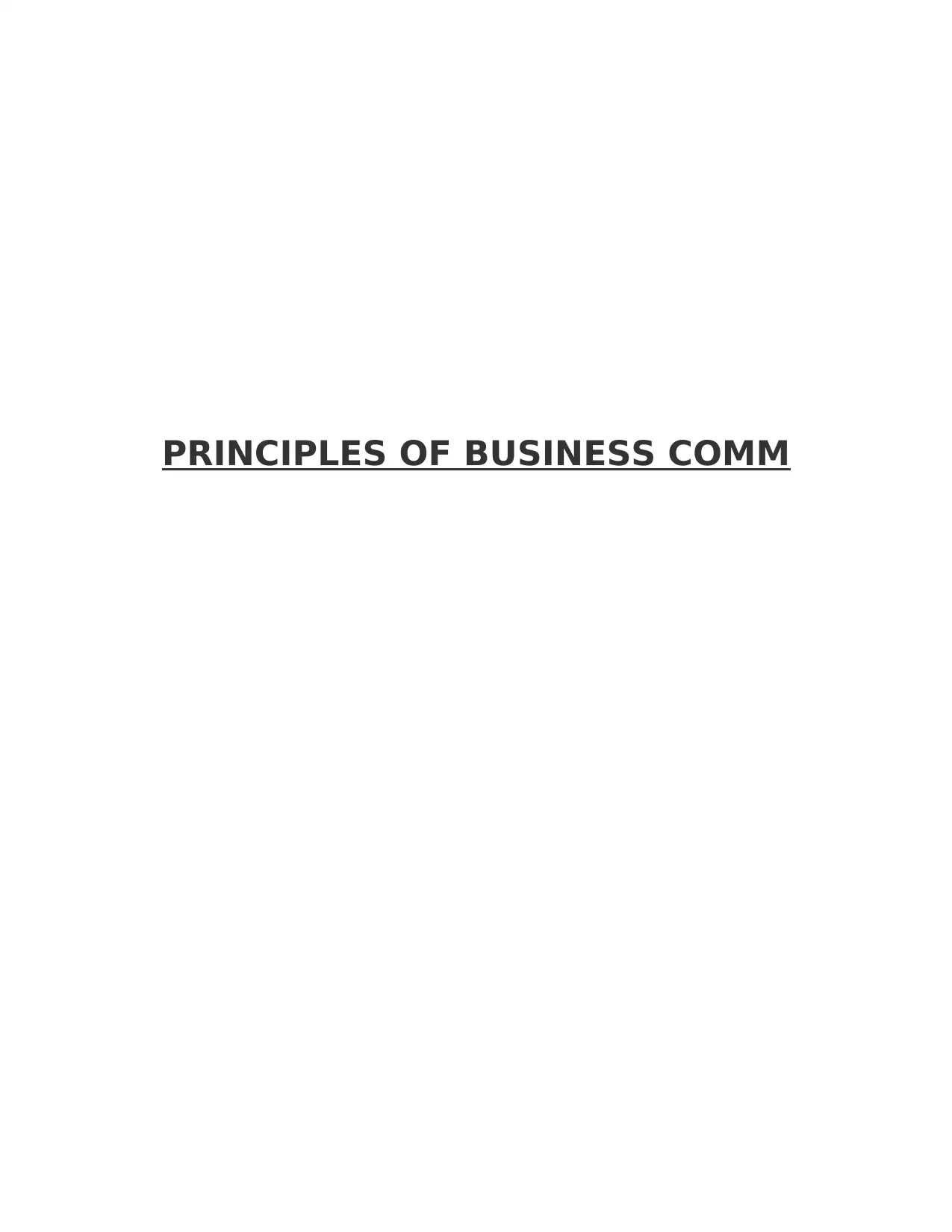
PRINCIPLES OF BUSINESS COMM
Paraphrase This Document
Need a fresh take? Get an instant paraphrase of this document with our AI Paraphraser
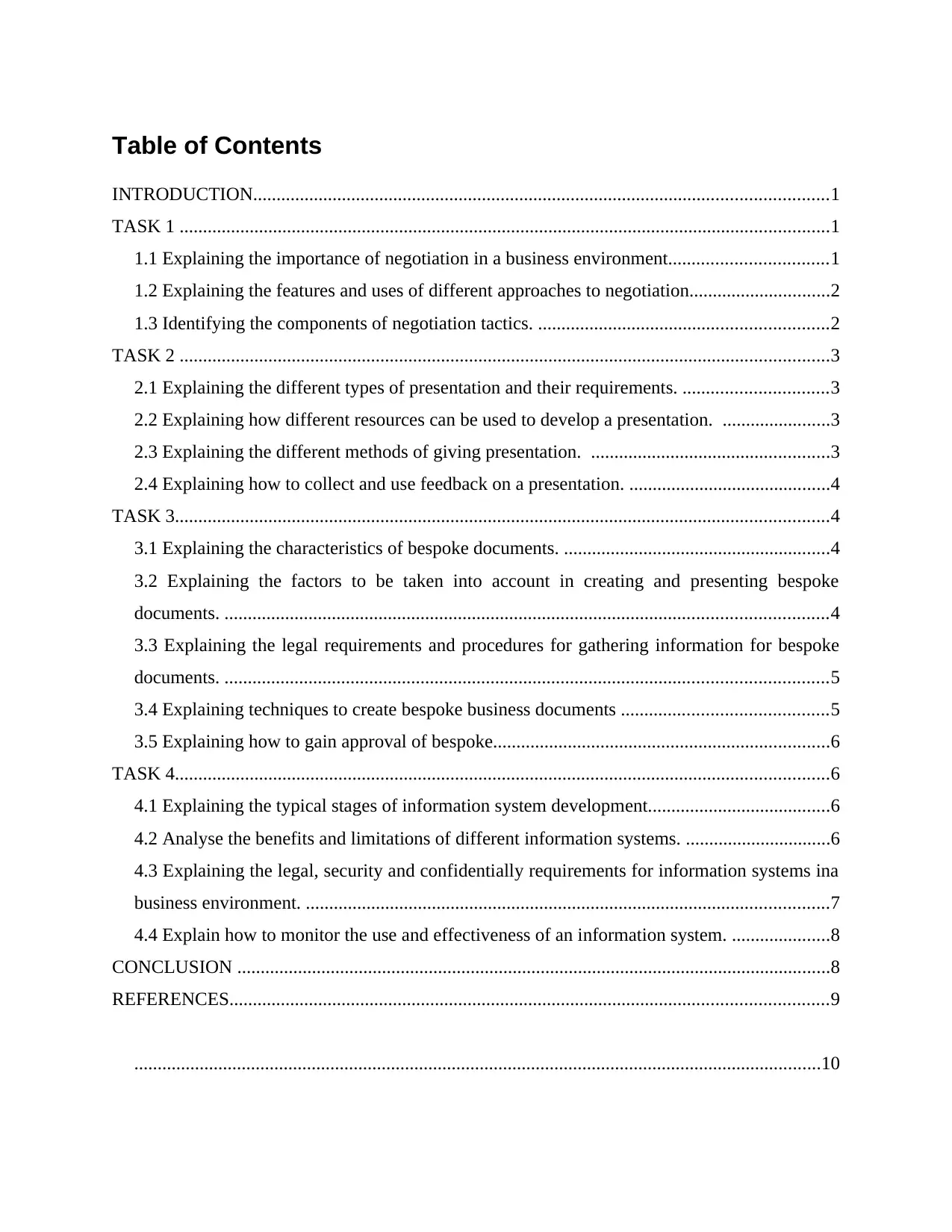
Table of Contents
INTRODUCTION...........................................................................................................................1
TASK 1 ...........................................................................................................................................1
1.1 Explaining the importance of negotiation in a business environment..................................1
1.2 Explaining the features and uses of different approaches to negotiation..............................2
1.3 Identifying the components of negotiation tactics. ..............................................................2
TASK 2 ...........................................................................................................................................3
2.1 Explaining the different types of presentation and their requirements. ...............................3
2.2 Explaining how different resources can be used to develop a presentation. .......................3
2.3 Explaining the different methods of giving presentation. ...................................................3
2.4 Explaining how to collect and use feedback on a presentation. ...........................................4
TASK 3............................................................................................................................................4
3.1 Explaining the characteristics of bespoke documents. .........................................................4
3.2 Explaining the factors to be taken into account in creating and presenting bespoke
documents. .................................................................................................................................4
3.3 Explaining the legal requirements and procedures for gathering information for bespoke
documents. .................................................................................................................................5
3.4 Explaining techniques to create bespoke business documents ............................................5
3.5 Explaining how to gain approval of bespoke........................................................................6
TASK 4............................................................................................................................................6
4.1 Explaining the typical stages of information system development.......................................6
4.2 Analyse the benefits and limitations of different information systems. ...............................6
4.3 Explaining the legal, security and confidentially requirements for information systems ina
business environment. ................................................................................................................7
4.4 Explain how to monitor the use and effectiveness of an information system. .....................8
CONCLUSION ...............................................................................................................................8
REFERENCES................................................................................................................................9
...................................................................................................................................................10
INTRODUCTION...........................................................................................................................1
TASK 1 ...........................................................................................................................................1
1.1 Explaining the importance of negotiation in a business environment..................................1
1.2 Explaining the features and uses of different approaches to negotiation..............................2
1.3 Identifying the components of negotiation tactics. ..............................................................2
TASK 2 ...........................................................................................................................................3
2.1 Explaining the different types of presentation and their requirements. ...............................3
2.2 Explaining how different resources can be used to develop a presentation. .......................3
2.3 Explaining the different methods of giving presentation. ...................................................3
2.4 Explaining how to collect and use feedback on a presentation. ...........................................4
TASK 3............................................................................................................................................4
3.1 Explaining the characteristics of bespoke documents. .........................................................4
3.2 Explaining the factors to be taken into account in creating and presenting bespoke
documents. .................................................................................................................................4
3.3 Explaining the legal requirements and procedures for gathering information for bespoke
documents. .................................................................................................................................5
3.4 Explaining techniques to create bespoke business documents ............................................5
3.5 Explaining how to gain approval of bespoke........................................................................6
TASK 4............................................................................................................................................6
4.1 Explaining the typical stages of information system development.......................................6
4.2 Analyse the benefits and limitations of different information systems. ...............................6
4.3 Explaining the legal, security and confidentially requirements for information systems ina
business environment. ................................................................................................................7
4.4 Explain how to monitor the use and effectiveness of an information system. .....................8
CONCLUSION ...............................................................................................................................8
REFERENCES................................................................................................................................9
...................................................................................................................................................10
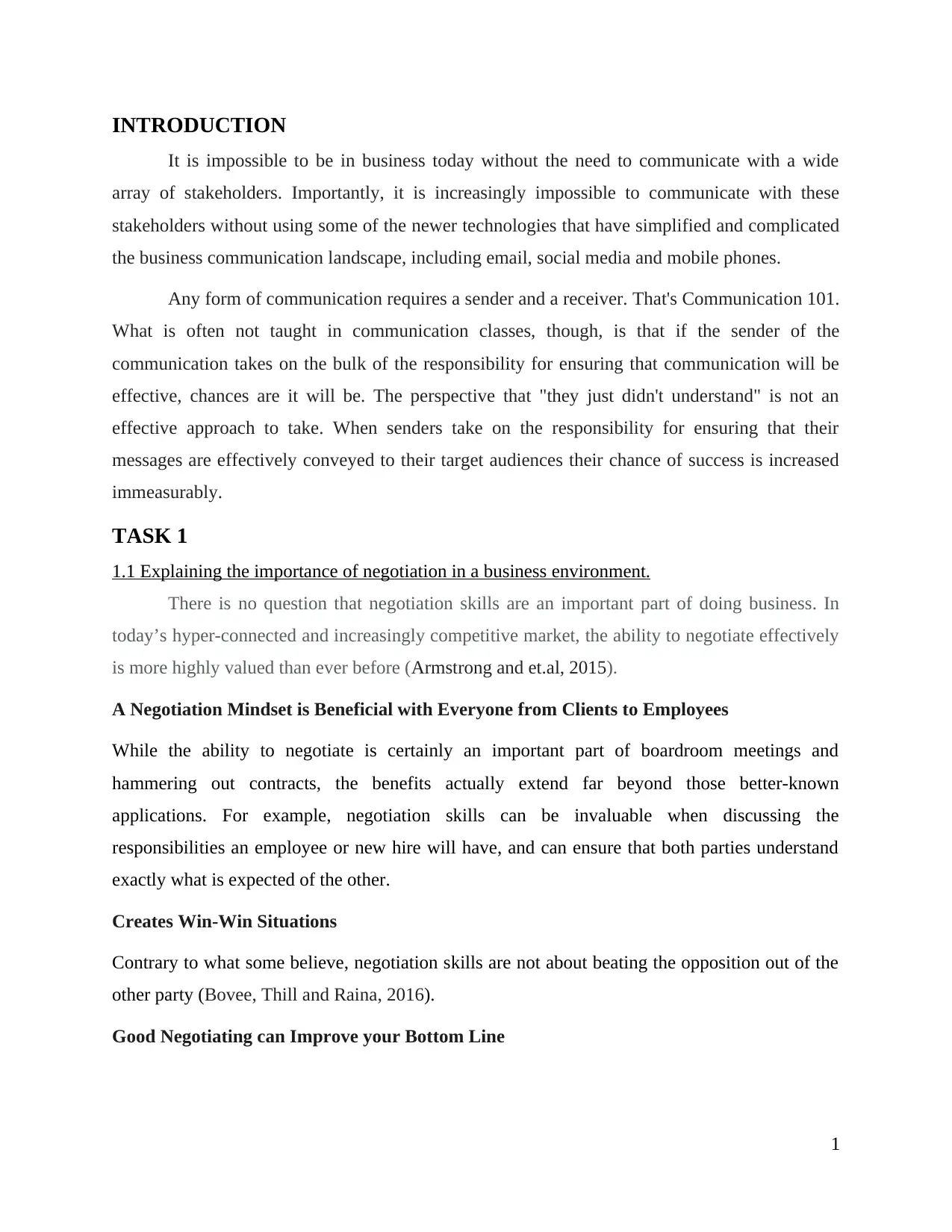
INTRODUCTION
It is impossible to be in business today without the need to communicate with a wide
array of stakeholders. Importantly, it is increasingly impossible to communicate with these
stakeholders without using some of the newer technologies that have simplified and complicated
the business communication landscape, including email, social media and mobile phones.
Any form of communication requires a sender and a receiver. That's Communication 101.
What is often not taught in communication classes, though, is that if the sender of the
communication takes on the bulk of the responsibility for ensuring that communication will be
effective, chances are it will be. The perspective that "they just didn't understand" is not an
effective approach to take. When senders take on the responsibility for ensuring that their
messages are effectively conveyed to their target audiences their chance of success is increased
immeasurably.
TASK 1
1.1 Explaining the importance of negotiation in a business environment.
There is no question that negotiation skills are an important part of doing business. In
today’s hyper-connected and increasingly competitive market, the ability to negotiate effectively
is more highly valued than ever before (Armstrong and et.al, 2015).
A Negotiation Mindset is Beneficial with Everyone from Clients to Employees
While the ability to negotiate is certainly an important part of boardroom meetings and
hammering out contracts, the benefits actually extend far beyond those better-known
applications. For example, negotiation skills can be invaluable when discussing the
responsibilities an employee or new hire will have, and can ensure that both parties understand
exactly what is expected of the other.
Creates Win-Win Situations
Contrary to what some believe, negotiation skills are not about beating the opposition out of the
other party (Bovee, Thill and Raina, 2016).
Good Negotiating can Improve your Bottom Line
1
It is impossible to be in business today without the need to communicate with a wide
array of stakeholders. Importantly, it is increasingly impossible to communicate with these
stakeholders without using some of the newer technologies that have simplified and complicated
the business communication landscape, including email, social media and mobile phones.
Any form of communication requires a sender and a receiver. That's Communication 101.
What is often not taught in communication classes, though, is that if the sender of the
communication takes on the bulk of the responsibility for ensuring that communication will be
effective, chances are it will be. The perspective that "they just didn't understand" is not an
effective approach to take. When senders take on the responsibility for ensuring that their
messages are effectively conveyed to their target audiences their chance of success is increased
immeasurably.
TASK 1
1.1 Explaining the importance of negotiation in a business environment.
There is no question that negotiation skills are an important part of doing business. In
today’s hyper-connected and increasingly competitive market, the ability to negotiate effectively
is more highly valued than ever before (Armstrong and et.al, 2015).
A Negotiation Mindset is Beneficial with Everyone from Clients to Employees
While the ability to negotiate is certainly an important part of boardroom meetings and
hammering out contracts, the benefits actually extend far beyond those better-known
applications. For example, negotiation skills can be invaluable when discussing the
responsibilities an employee or new hire will have, and can ensure that both parties understand
exactly what is expected of the other.
Creates Win-Win Situations
Contrary to what some believe, negotiation skills are not about beating the opposition out of the
other party (Bovee, Thill and Raina, 2016).
Good Negotiating can Improve your Bottom Line
1
⊘ This is a preview!⊘
Do you want full access?
Subscribe today to unlock all pages.

Trusted by 1+ million students worldwide
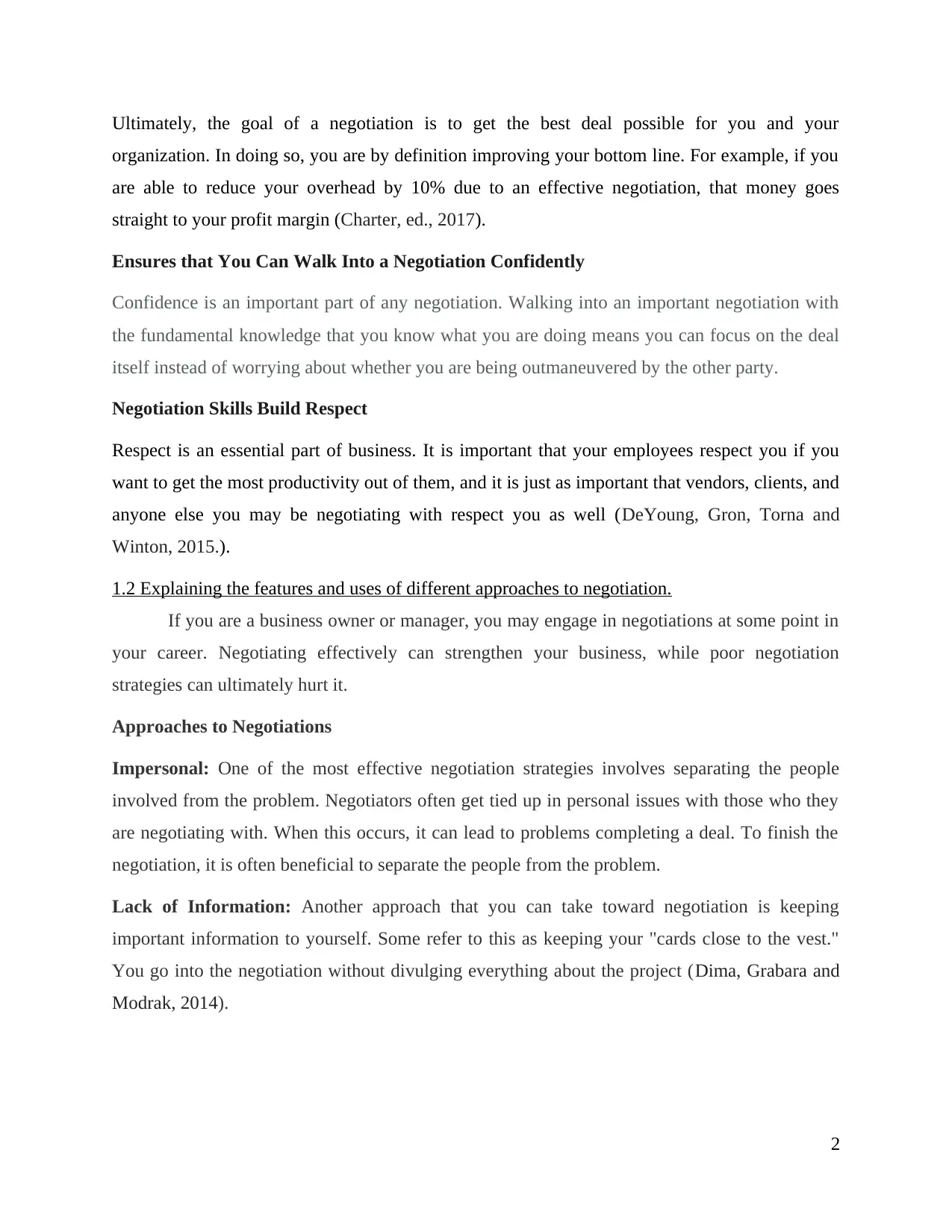
Ultimately, the goal of a negotiation is to get the best deal possible for you and your
organization. In doing so, you are by definition improving your bottom line. For example, if you
are able to reduce your overhead by 10% due to an effective negotiation, that money goes
straight to your profit margin (Charter, ed., 2017).
Ensures that You Can Walk Into a Negotiation Confidently
Confidence is an important part of any negotiation. Walking into an important negotiation with
the fundamental knowledge that you know what you are doing means you can focus on the deal
itself instead of worrying about whether you are being outmaneuvered by the other party.
Negotiation Skills Build Respect
Respect is an essential part of business. It is important that your employees respect you if you
want to get the most productivity out of them, and it is just as important that vendors, clients, and
anyone else you may be negotiating with respect you as well (DeYoung, Gron, Torna and
Winton, 2015.).
1.2 Explaining the features and uses of different approaches to negotiation.
If you are a business owner or manager, you may engage in negotiations at some point in
your career. Negotiating effectively can strengthen your business, while poor negotiation
strategies can ultimately hurt it.
Approaches to Negotiations
Impersonal: One of the most effective negotiation strategies involves separating the people
involved from the problem. Negotiators often get tied up in personal issues with those who they
are negotiating with. When this occurs, it can lead to problems completing a deal. To finish the
negotiation, it is often beneficial to separate the people from the problem.
Lack of Information: Another approach that you can take toward negotiation is keeping
important information to yourself. Some refer to this as keeping your "cards close to the vest."
You go into the negotiation without divulging everything about the project (Dima, Grabara and
Modrak, 2014).
2
organization. In doing so, you are by definition improving your bottom line. For example, if you
are able to reduce your overhead by 10% due to an effective negotiation, that money goes
straight to your profit margin (Charter, ed., 2017).
Ensures that You Can Walk Into a Negotiation Confidently
Confidence is an important part of any negotiation. Walking into an important negotiation with
the fundamental knowledge that you know what you are doing means you can focus on the deal
itself instead of worrying about whether you are being outmaneuvered by the other party.
Negotiation Skills Build Respect
Respect is an essential part of business. It is important that your employees respect you if you
want to get the most productivity out of them, and it is just as important that vendors, clients, and
anyone else you may be negotiating with respect you as well (DeYoung, Gron, Torna and
Winton, 2015.).
1.2 Explaining the features and uses of different approaches to negotiation.
If you are a business owner or manager, you may engage in negotiations at some point in
your career. Negotiating effectively can strengthen your business, while poor negotiation
strategies can ultimately hurt it.
Approaches to Negotiations
Impersonal: One of the most effective negotiation strategies involves separating the people
involved from the problem. Negotiators often get tied up in personal issues with those who they
are negotiating with. When this occurs, it can lead to problems completing a deal. To finish the
negotiation, it is often beneficial to separate the people from the problem.
Lack of Information: Another approach that you can take toward negotiation is keeping
important information to yourself. Some refer to this as keeping your "cards close to the vest."
You go into the negotiation without divulging everything about the project (Dima, Grabara and
Modrak, 2014).
2
Paraphrase This Document
Need a fresh take? Get an instant paraphrase of this document with our AI Paraphraser
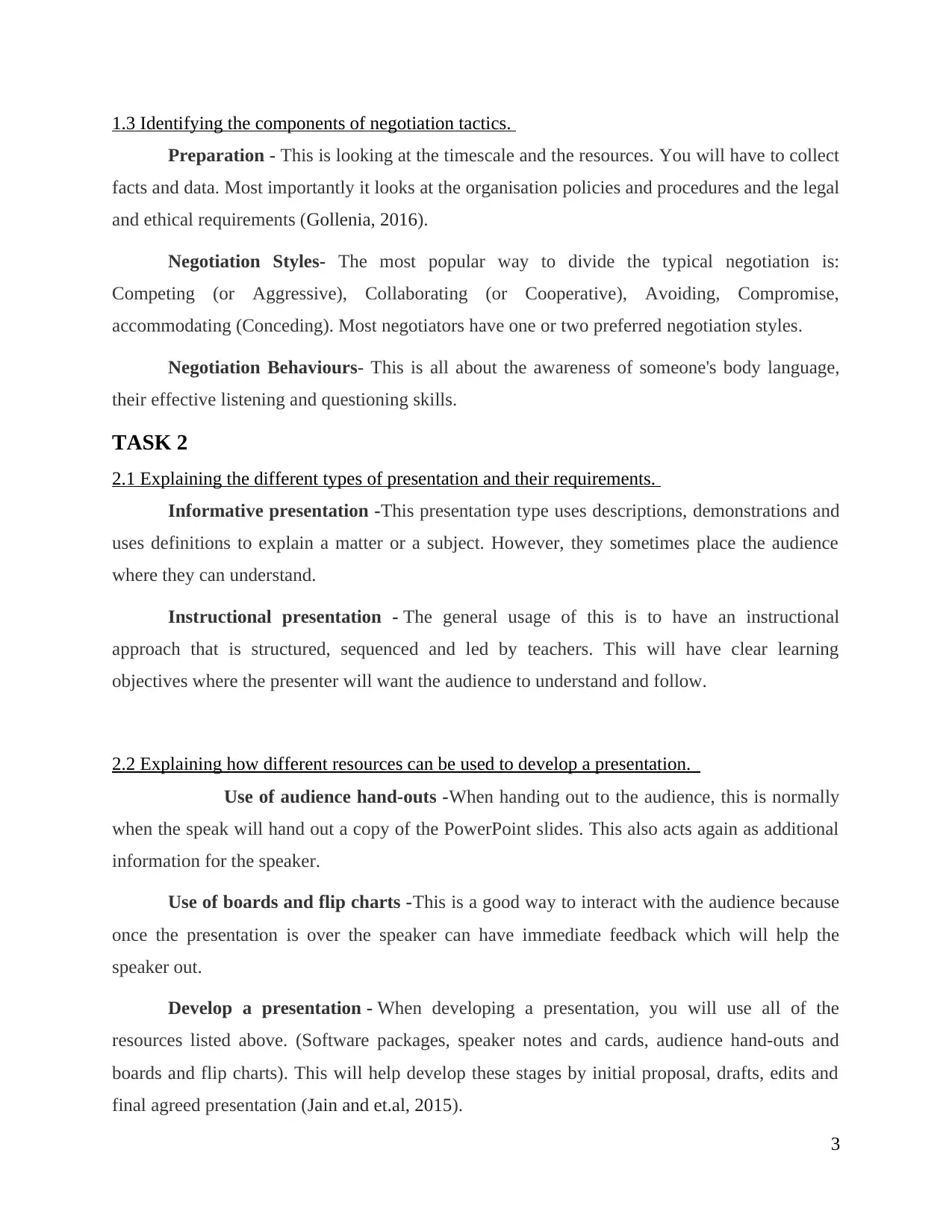
1.3 Identifying the components of negotiation tactics.
Preparation - This is looking at the timescale and the resources. You will have to collect
facts and data. Most importantly it looks at the organisation policies and procedures and the legal
and ethical requirements (Gollenia, 2016).
Negotiation Styles- The most popular way to divide the typical negotiation is:
Competing (or Aggressive), Collaborating (or Cooperative), Avoiding, Compromise,
accommodating (Conceding). Most negotiators have one or two preferred negotiation styles.
Negotiation Behaviours- This is all about the awareness of someone's body language,
their effective listening and questioning skills.
TASK 2
2.1 Explaining the different types of presentation and their requirements.
Informative presentation -This presentation type uses descriptions, demonstrations and
uses definitions to explain a matter or a subject. However, they sometimes place the audience
where they can understand.
Instructional presentation - The general usage of this is to have an instructional
approach that is structured, sequenced and led by teachers. This will have clear learning
objectives where the presenter will want the audience to understand and follow.
2.2 Explaining how different resources can be used to develop a presentation.
Use of audience hand-outs -When handing out to the audience, this is normally
when the speak will hand out a copy of the PowerPoint slides. This also acts again as additional
information for the speaker.
Use of boards and flip charts -This is a good way to interact with the audience because
once the presentation is over the speaker can have immediate feedback which will help the
speaker out.
Develop a presentation - When developing a presentation, you will use all of the
resources listed above. (Software packages, speaker notes and cards, audience hand-outs and
boards and flip charts). This will help develop these stages by initial proposal, drafts, edits and
final agreed presentation (Jain and et.al, 2015).
3
Preparation - This is looking at the timescale and the resources. You will have to collect
facts and data. Most importantly it looks at the organisation policies and procedures and the legal
and ethical requirements (Gollenia, 2016).
Negotiation Styles- The most popular way to divide the typical negotiation is:
Competing (or Aggressive), Collaborating (or Cooperative), Avoiding, Compromise,
accommodating (Conceding). Most negotiators have one or two preferred negotiation styles.
Negotiation Behaviours- This is all about the awareness of someone's body language,
their effective listening and questioning skills.
TASK 2
2.1 Explaining the different types of presentation and their requirements.
Informative presentation -This presentation type uses descriptions, demonstrations and
uses definitions to explain a matter or a subject. However, they sometimes place the audience
where they can understand.
Instructional presentation - The general usage of this is to have an instructional
approach that is structured, sequenced and led by teachers. This will have clear learning
objectives where the presenter will want the audience to understand and follow.
2.2 Explaining how different resources can be used to develop a presentation.
Use of audience hand-outs -When handing out to the audience, this is normally
when the speak will hand out a copy of the PowerPoint slides. This also acts again as additional
information for the speaker.
Use of boards and flip charts -This is a good way to interact with the audience because
once the presentation is over the speaker can have immediate feedback which will help the
speaker out.
Develop a presentation - When developing a presentation, you will use all of the
resources listed above. (Software packages, speaker notes and cards, audience hand-outs and
boards and flip charts). This will help develop these stages by initial proposal, drafts, edits and
final agreed presentation (Jain and et.al, 2015).
3
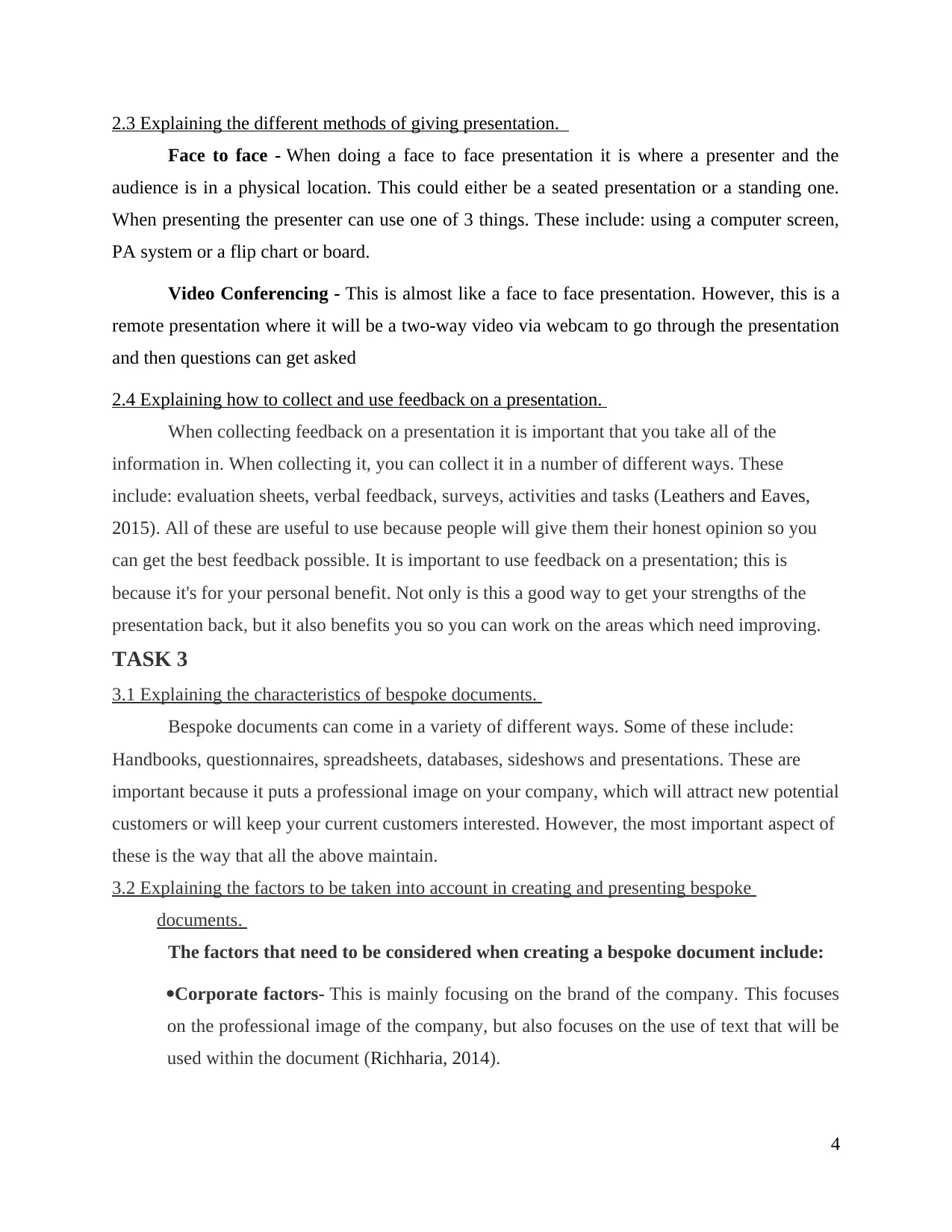
2.3 Explaining the different methods of giving presentation.
Face to face - When doing a face to face presentation it is where a presenter and the
audience is in a physical location. This could either be a seated presentation or a standing one.
When presenting the presenter can use one of 3 things. These include: using a computer screen,
PA system or a flip chart or board.
Video Conferencing - This is almost like a face to face presentation. However, this is a
remote presentation where it will be a two-way video via webcam to go through the presentation
and then questions can get asked
2.4 Explaining how to collect and use feedback on a presentation.
When collecting feedback on a presentation it is important that you take all of the
information in. When collecting it, you can collect it in a number of different ways. These
include: evaluation sheets, verbal feedback, surveys, activities and tasks (Leathers and Eaves,
2015). All of these are useful to use because people will give them their honest opinion so you
can get the best feedback possible. It is important to use feedback on a presentation; this is
because it's for your personal benefit. Not only is this a good way to get your strengths of the
presentation back, but it also benefits you so you can work on the areas which need improving.
TASK 3
3.1 Explaining the characteristics of bespoke documents.
Bespoke documents can come in a variety of different ways. Some of these include:
Handbooks, questionnaires, spreadsheets, databases, sideshows and presentations. These are
important because it puts a professional image on your company, which will attract new potential
customers or will keep your current customers interested. However, the most important aspect of
these is the way that all the above maintain.
3.2 Explaining the factors to be taken into account in creating and presenting bespoke
documents.
The factors that need to be considered when creating a bespoke document include:
Corporate factors- This is mainly focusing on the brand of the company. This focuses
on the professional image of the company, but also focuses on the use of text that will be
used within the document (Richharia, 2014).
4
Face to face - When doing a face to face presentation it is where a presenter and the
audience is in a physical location. This could either be a seated presentation or a standing one.
When presenting the presenter can use one of 3 things. These include: using a computer screen,
PA system or a flip chart or board.
Video Conferencing - This is almost like a face to face presentation. However, this is a
remote presentation where it will be a two-way video via webcam to go through the presentation
and then questions can get asked
2.4 Explaining how to collect and use feedback on a presentation.
When collecting feedback on a presentation it is important that you take all of the
information in. When collecting it, you can collect it in a number of different ways. These
include: evaluation sheets, verbal feedback, surveys, activities and tasks (Leathers and Eaves,
2015). All of these are useful to use because people will give them their honest opinion so you
can get the best feedback possible. It is important to use feedback on a presentation; this is
because it's for your personal benefit. Not only is this a good way to get your strengths of the
presentation back, but it also benefits you so you can work on the areas which need improving.
TASK 3
3.1 Explaining the characteristics of bespoke documents.
Bespoke documents can come in a variety of different ways. Some of these include:
Handbooks, questionnaires, spreadsheets, databases, sideshows and presentations. These are
important because it puts a professional image on your company, which will attract new potential
customers or will keep your current customers interested. However, the most important aspect of
these is the way that all the above maintain.
3.2 Explaining the factors to be taken into account in creating and presenting bespoke
documents.
The factors that need to be considered when creating a bespoke document include:
Corporate factors- This is mainly focusing on the brand of the company. This focuses
on the professional image of the company, but also focuses on the use of text that will be
used within the document (Richharia, 2014).
4
⊘ This is a preview!⊘
Do you want full access?
Subscribe today to unlock all pages.

Trusted by 1+ million students worldwide
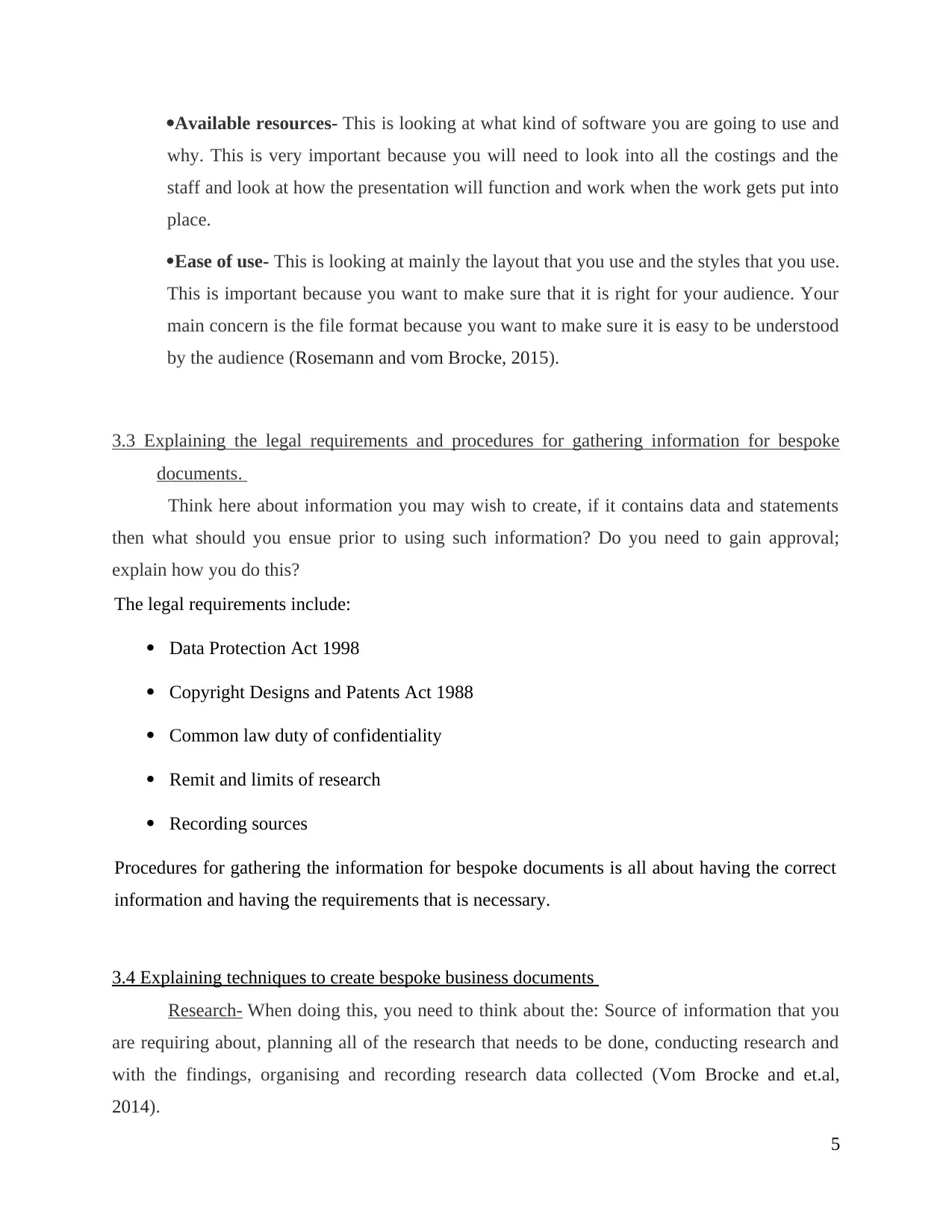
Available resources- This is looking at what kind of software you are going to use and
why. This is very important because you will need to look into all the costings and the
staff and look at how the presentation will function and work when the work gets put into
place.
Ease of use- This is looking at mainly the layout that you use and the styles that you use.
This is important because you want to make sure that it is right for your audience. Your
main concern is the file format because you want to make sure it is easy to be understood
by the audience (Rosemann and vom Brocke, 2015).
3.3 Explaining the legal requirements and procedures for gathering information for bespoke
documents.
Think here about information you may wish to create, if it contains data and statements
then what should you ensue prior to using such information? Do you need to gain approval;
explain how you do this?
The legal requirements include:
Data Protection Act 1998
Copyright Designs and Patents Act 1988
Common law duty of confidentiality
Remit and limits of research
Recording sources
Procedures for gathering the information for bespoke documents is all about having the correct
information and having the requirements that is necessary.
3.4 Explaining techniques to create bespoke business documents
Research- When doing this, you need to think about the: Source of information that you
are requiring about, planning all of the research that needs to be done, conducting research and
with the findings, organising and recording research data collected (Vom Brocke and et.al,
2014).
5
why. This is very important because you will need to look into all the costings and the
staff and look at how the presentation will function and work when the work gets put into
place.
Ease of use- This is looking at mainly the layout that you use and the styles that you use.
This is important because you want to make sure that it is right for your audience. Your
main concern is the file format because you want to make sure it is easy to be understood
by the audience (Rosemann and vom Brocke, 2015).
3.3 Explaining the legal requirements and procedures for gathering information for bespoke
documents.
Think here about information you may wish to create, if it contains data and statements
then what should you ensue prior to using such information? Do you need to gain approval;
explain how you do this?
The legal requirements include:
Data Protection Act 1998
Copyright Designs and Patents Act 1988
Common law duty of confidentiality
Remit and limits of research
Recording sources
Procedures for gathering the information for bespoke documents is all about having the correct
information and having the requirements that is necessary.
3.4 Explaining techniques to create bespoke business documents
Research- When doing this, you need to think about the: Source of information that you
are requiring about, planning all of the research that needs to be done, conducting research and
with the findings, organising and recording research data collected (Vom Brocke and et.al,
2014).
5
Paraphrase This Document
Need a fresh take? Get an instant paraphrase of this document with our AI Paraphraser
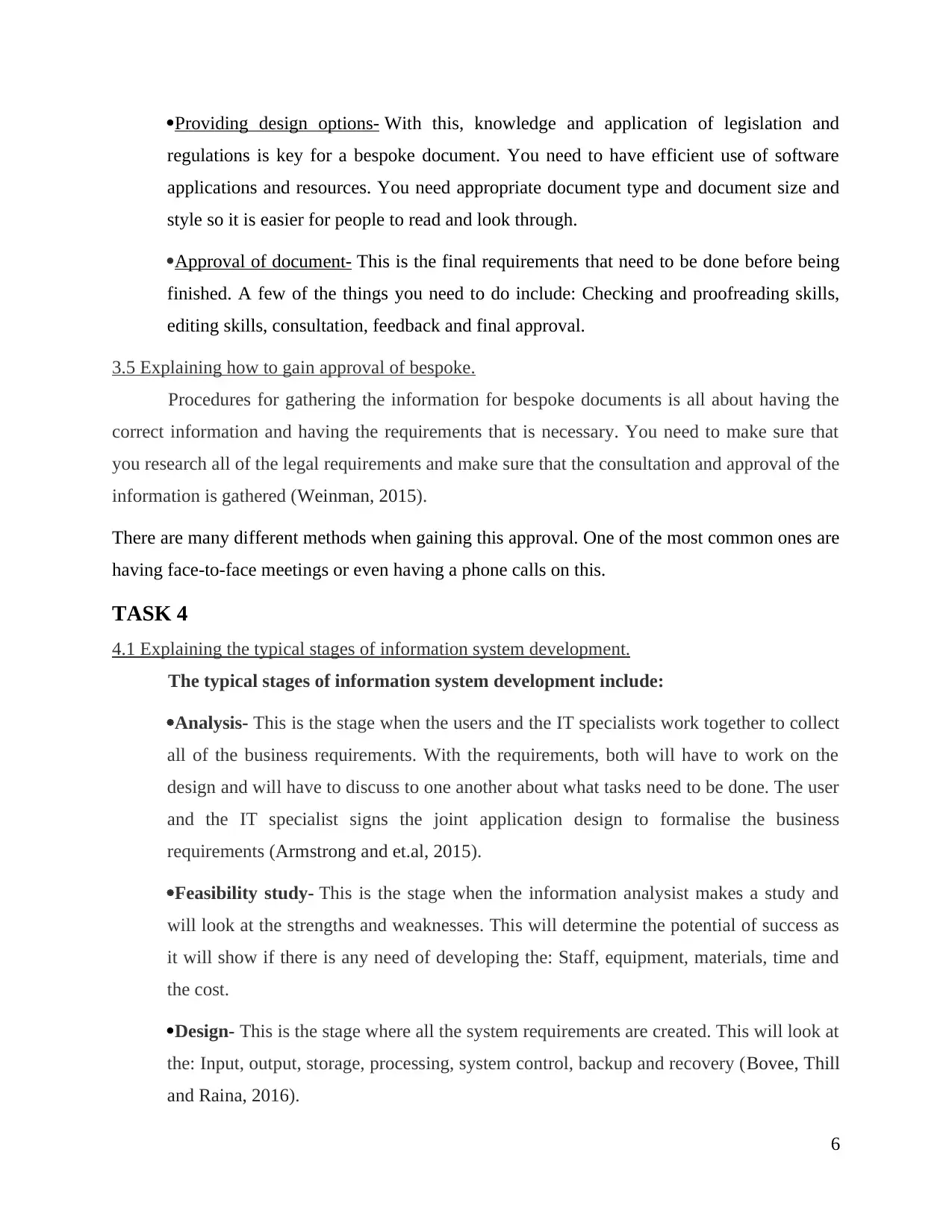
Providing design options- With this, knowledge and application of legislation and
regulations is key for a bespoke document. You need to have efficient use of software
applications and resources. You need appropriate document type and document size and
style so it is easier for people to read and look through.
Approval of document- This is the final requirements that need to be done before being
finished. A few of the things you need to do include: Checking and proofreading skills,
editing skills, consultation, feedback and final approval.
3.5 Explaining how to gain approval of bespoke.
Procedures for gathering the information for bespoke documents is all about having the
correct information and having the requirements that is necessary. You need to make sure that
you research all of the legal requirements and make sure that the consultation and approval of the
information is gathered (Weinman, 2015).
There are many different methods when gaining this approval. One of the most common ones are
having face-to-face meetings or even having a phone calls on this.
TASK 4
4.1 Explaining the typical stages of information system development.
The typical stages of information system development include:
Analysis- This is the stage when the users and the IT specialists work together to collect
all of the business requirements. With the requirements, both will have to work on the
design and will have to discuss to one another about what tasks need to be done. The user
and the IT specialist signs the joint application design to formalise the business
requirements (Armstrong and et.al, 2015).
Feasibility study- This is the stage when the information analysist makes a study and
will look at the strengths and weaknesses. This will determine the potential of success as
it will show if there is any need of developing the: Staff, equipment, materials, time and
the cost.
Design- This is the stage where all the system requirements are created. This will look at
the: Input, output, storage, processing, system control, backup and recovery (Bovee, Thill
and Raina, 2016).
6
regulations is key for a bespoke document. You need to have efficient use of software
applications and resources. You need appropriate document type and document size and
style so it is easier for people to read and look through.
Approval of document- This is the final requirements that need to be done before being
finished. A few of the things you need to do include: Checking and proofreading skills,
editing skills, consultation, feedback and final approval.
3.5 Explaining how to gain approval of bespoke.
Procedures for gathering the information for bespoke documents is all about having the
correct information and having the requirements that is necessary. You need to make sure that
you research all of the legal requirements and make sure that the consultation and approval of the
information is gathered (Weinman, 2015).
There are many different methods when gaining this approval. One of the most common ones are
having face-to-face meetings or even having a phone calls on this.
TASK 4
4.1 Explaining the typical stages of information system development.
The typical stages of information system development include:
Analysis- This is the stage when the users and the IT specialists work together to collect
all of the business requirements. With the requirements, both will have to work on the
design and will have to discuss to one another about what tasks need to be done. The user
and the IT specialist signs the joint application design to formalise the business
requirements (Armstrong and et.al, 2015).
Feasibility study- This is the stage when the information analysist makes a study and
will look at the strengths and weaknesses. This will determine the potential of success as
it will show if there is any need of developing the: Staff, equipment, materials, time and
the cost.
Design- This is the stage where all the system requirements are created. This will look at
the: Input, output, storage, processing, system control, backup and recovery (Bovee, Thill
and Raina, 2016).
6
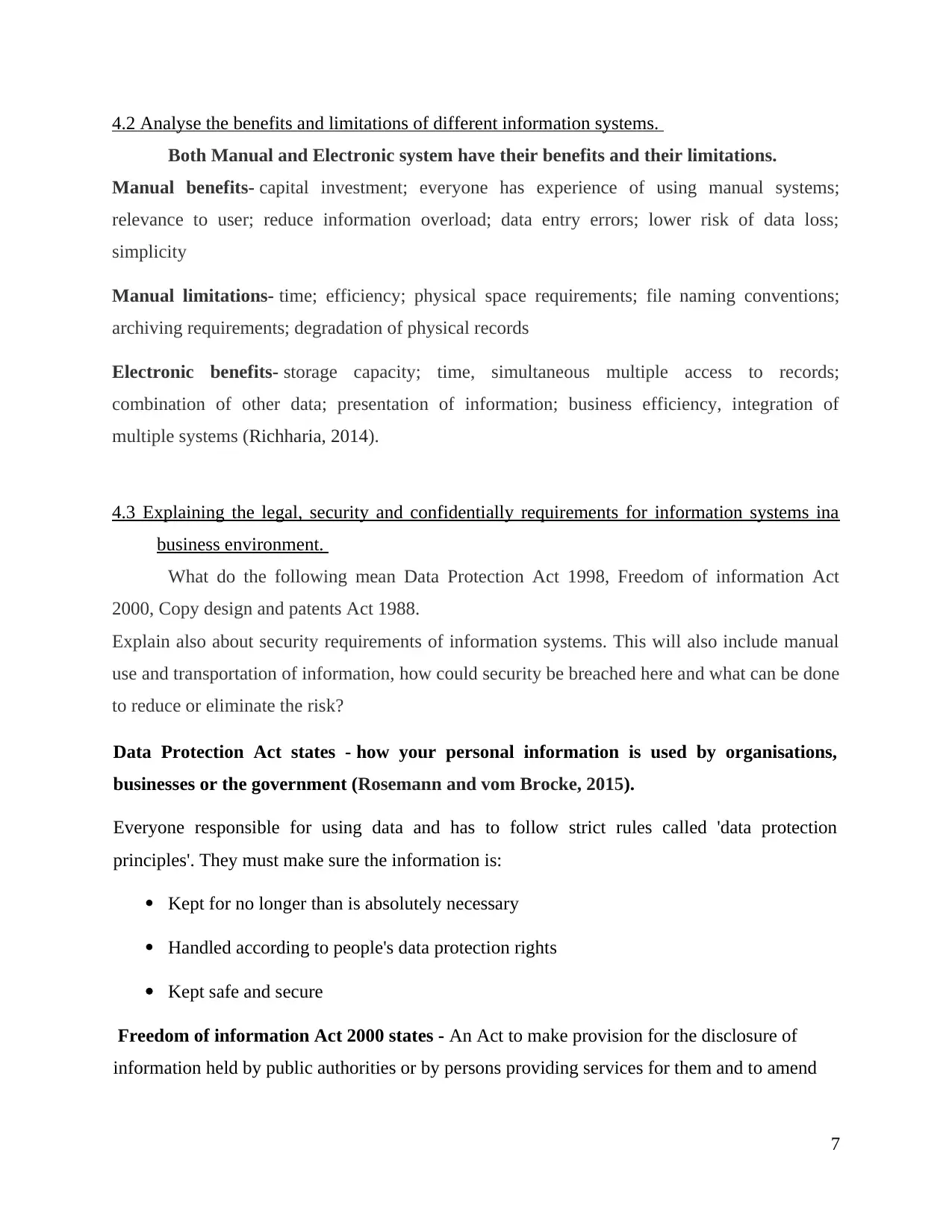
4.2 Analyse the benefits and limitations of different information systems.
Both Manual and Electronic system have their benefits and their limitations.
Manual benefits- capital investment; everyone has experience of using manual systems;
relevance to user; reduce information overload; data entry errors; lower risk of data loss;
simplicity
Manual limitations- time; efficiency; physical space requirements; file naming conventions;
archiving requirements; degradation of physical records
Electronic benefits- storage capacity; time, simultaneous multiple access to records;
combination of other data; presentation of information; business efficiency, integration of
multiple systems (Richharia, 2014).
4.3 Explaining the legal, security and confidentially requirements for information systems ina
business environment.
What do the following mean Data Protection Act 1998, Freedom of information Act
2000, Copy design and patents Act 1988.
Explain also about security requirements of information systems. This will also include manual
use and transportation of information, how could security be breached here and what can be done
to reduce or eliminate the risk?
Data Protection Act states - how your personal information is used by organisations,
businesses or the government (Rosemann and vom Brocke, 2015).
Everyone responsible for using data and has to follow strict rules called 'data protection
principles'. They must make sure the information is:
Kept for no longer than is absolutely necessary
Handled according to people's data protection rights
Kept safe and secure
Freedom of information Act 2000 states - An Act to make provision for the disclosure of
information held by public authorities or by persons providing services for them and to amend
7
Both Manual and Electronic system have their benefits and their limitations.
Manual benefits- capital investment; everyone has experience of using manual systems;
relevance to user; reduce information overload; data entry errors; lower risk of data loss;
simplicity
Manual limitations- time; efficiency; physical space requirements; file naming conventions;
archiving requirements; degradation of physical records
Electronic benefits- storage capacity; time, simultaneous multiple access to records;
combination of other data; presentation of information; business efficiency, integration of
multiple systems (Richharia, 2014).
4.3 Explaining the legal, security and confidentially requirements for information systems ina
business environment.
What do the following mean Data Protection Act 1998, Freedom of information Act
2000, Copy design and patents Act 1988.
Explain also about security requirements of information systems. This will also include manual
use and transportation of information, how could security be breached here and what can be done
to reduce or eliminate the risk?
Data Protection Act states - how your personal information is used by organisations,
businesses or the government (Rosemann and vom Brocke, 2015).
Everyone responsible for using data and has to follow strict rules called 'data protection
principles'. They must make sure the information is:
Kept for no longer than is absolutely necessary
Handled according to people's data protection rights
Kept safe and secure
Freedom of information Act 2000 states - An Act to make provision for the disclosure of
information held by public authorities or by persons providing services for them and to amend
7
⊘ This is a preview!⊘
Do you want full access?
Subscribe today to unlock all pages.

Trusted by 1+ million students worldwide
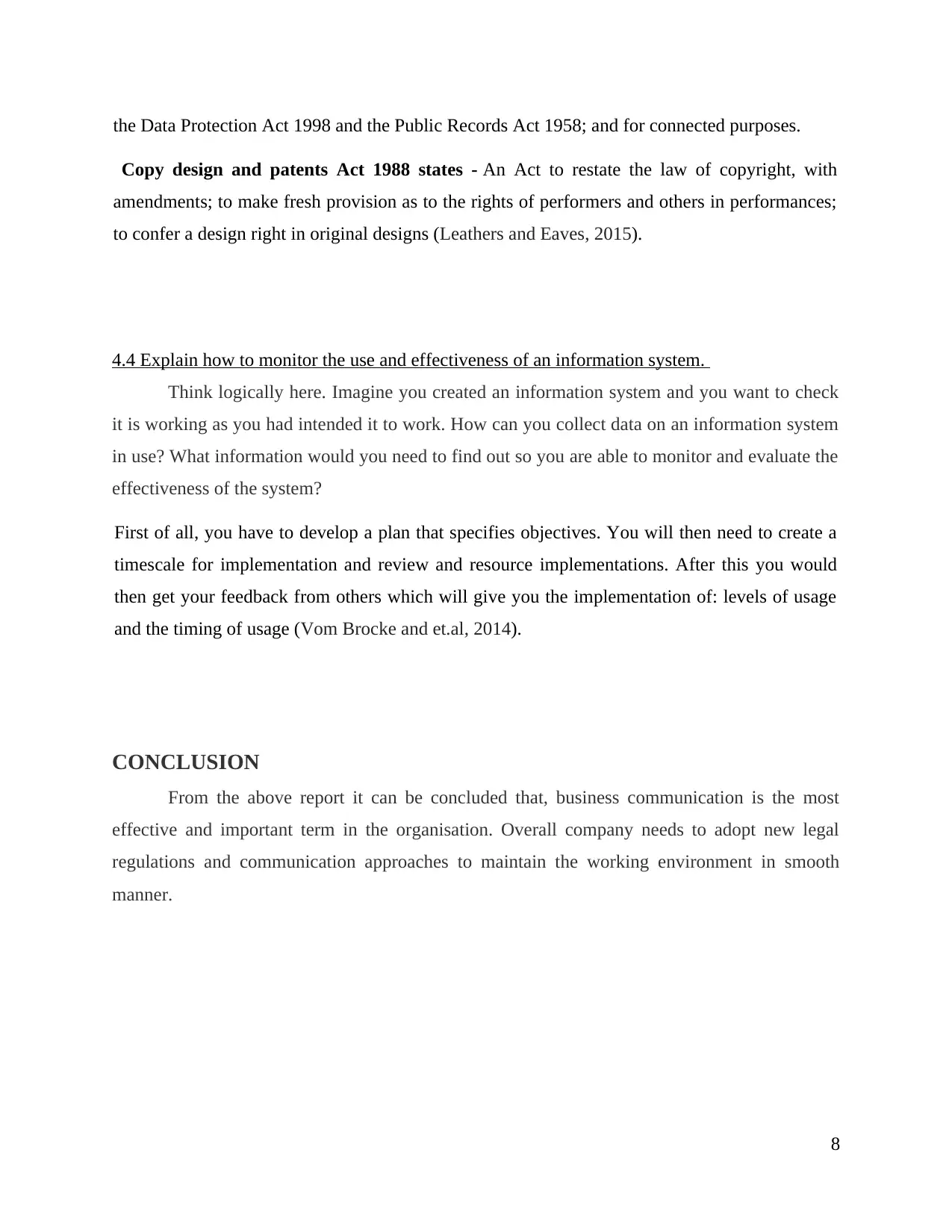
the Data Protection Act 1998 and the Public Records Act 1958; and for connected purposes.
Copy design and patents Act 1988 states - An Act to restate the law of copyright, with
amendments; to make fresh provision as to the rights of performers and others in performances;
to confer a design right in original designs (Leathers and Eaves, 2015).
4.4 Explain how to monitor the use and effectiveness of an information system.
Think logically here. Imagine you created an information system and you want to check
it is working as you had intended it to work. How can you collect data on an information system
in use? What information would you need to find out so you are able to monitor and evaluate the
effectiveness of the system?
First of all, you have to develop a plan that specifies objectives. You will then need to create a
timescale for implementation and review and resource implementations. After this you would
then get your feedback from others which will give you the implementation of: levels of usage
and the timing of usage (Vom Brocke and et.al, 2014).
CONCLUSION
From the above report it can be concluded that, business communication is the most
effective and important term in the organisation. Overall company needs to adopt new legal
regulations and communication approaches to maintain the working environment in smooth
manner.
8
Copy design and patents Act 1988 states - An Act to restate the law of copyright, with
amendments; to make fresh provision as to the rights of performers and others in performances;
to confer a design right in original designs (Leathers and Eaves, 2015).
4.4 Explain how to monitor the use and effectiveness of an information system.
Think logically here. Imagine you created an information system and you want to check
it is working as you had intended it to work. How can you collect data on an information system
in use? What information would you need to find out so you are able to monitor and evaluate the
effectiveness of the system?
First of all, you have to develop a plan that specifies objectives. You will then need to create a
timescale for implementation and review and resource implementations. After this you would
then get your feedback from others which will give you the implementation of: levels of usage
and the timing of usage (Vom Brocke and et.al, 2014).
CONCLUSION
From the above report it can be concluded that, business communication is the most
effective and important term in the organisation. Overall company needs to adopt new legal
regulations and communication approaches to maintain the working environment in smooth
manner.
8
Paraphrase This Document
Need a fresh take? Get an instant paraphrase of this document with our AI Paraphraser
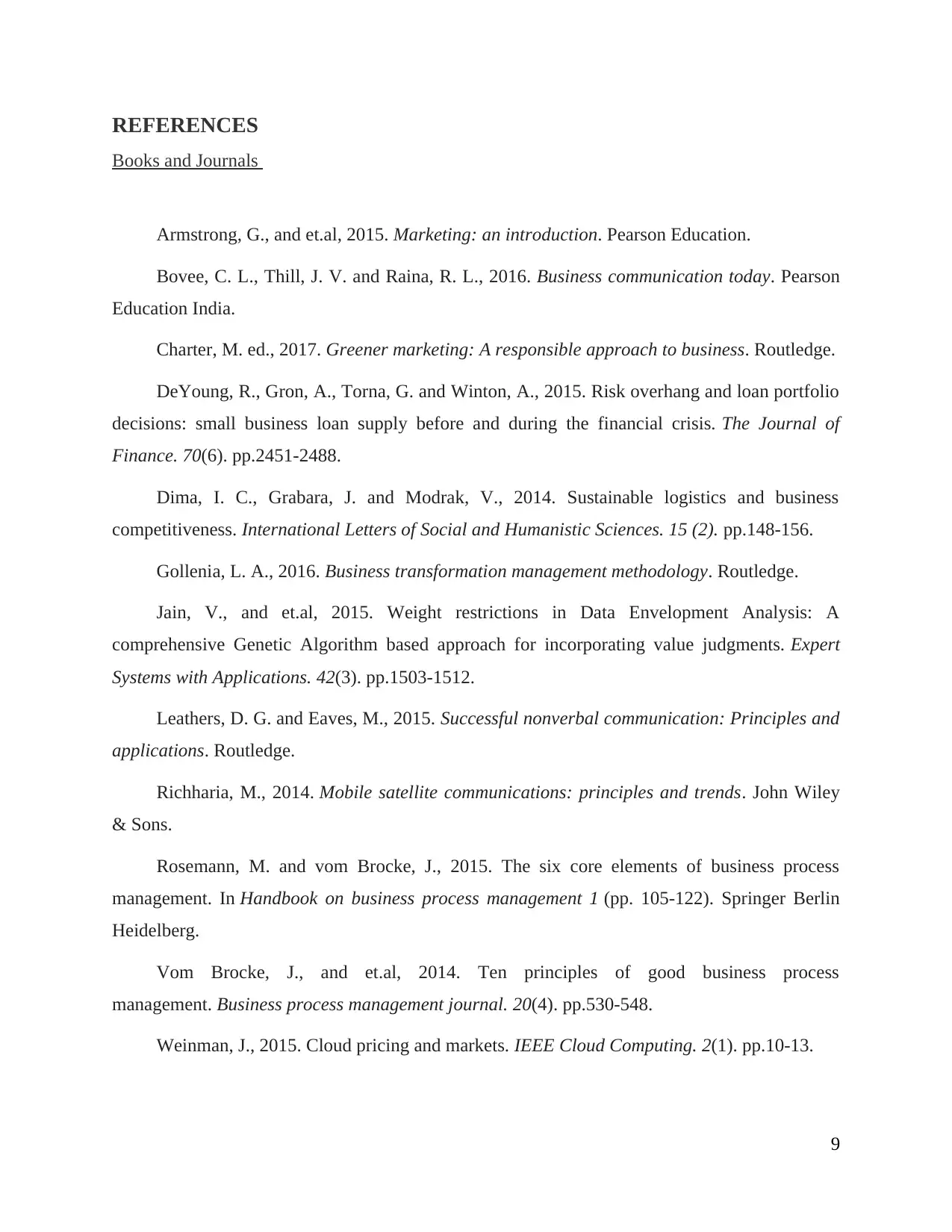
REFERENCES
Books and Journals
Armstrong, G., and et.al, 2015. Marketing: an introduction. Pearson Education.
Bovee, C. L., Thill, J. V. and Raina, R. L., 2016. Business communication today. Pearson
Education India.
Charter, M. ed., 2017. Greener marketing: A responsible approach to business. Routledge.
DeYoung, R., Gron, A., Torna, G. and Winton, A., 2015. Risk overhang and loan portfolio
decisions: small business loan supply before and during the financial crisis. The Journal of
Finance. 70(6). pp.2451-2488.
Dima, I. C., Grabara, J. and Modrak, V., 2014. Sustainable logistics and business
competitiveness. International Letters of Social and Humanistic Sciences. 15 (2). pp.148-156.
Gollenia, L. A., 2016. Business transformation management methodology. Routledge.
Jain, V., and et.al, 2015. Weight restrictions in Data Envelopment Analysis: A
comprehensive Genetic Algorithm based approach for incorporating value judgments. Expert
Systems with Applications. 42(3). pp.1503-1512.
Leathers, D. G. and Eaves, M., 2015. Successful nonverbal communication: Principles and
applications. Routledge.
Richharia, M., 2014. Mobile satellite communications: principles and trends. John Wiley
& Sons.
Rosemann, M. and vom Brocke, J., 2015. The six core elements of business process
management. In Handbook on business process management 1 (pp. 105-122). Springer Berlin
Heidelberg.
Vom Brocke, J., and et.al, 2014. Ten principles of good business process
management. Business process management journal. 20(4). pp.530-548.
Weinman, J., 2015. Cloud pricing and markets. IEEE Cloud Computing. 2(1). pp.10-13.
9
Books and Journals
Armstrong, G., and et.al, 2015. Marketing: an introduction. Pearson Education.
Bovee, C. L., Thill, J. V. and Raina, R. L., 2016. Business communication today. Pearson
Education India.
Charter, M. ed., 2017. Greener marketing: A responsible approach to business. Routledge.
DeYoung, R., Gron, A., Torna, G. and Winton, A., 2015. Risk overhang and loan portfolio
decisions: small business loan supply before and during the financial crisis. The Journal of
Finance. 70(6). pp.2451-2488.
Dima, I. C., Grabara, J. and Modrak, V., 2014. Sustainable logistics and business
competitiveness. International Letters of Social and Humanistic Sciences. 15 (2). pp.148-156.
Gollenia, L. A., 2016. Business transformation management methodology. Routledge.
Jain, V., and et.al, 2015. Weight restrictions in Data Envelopment Analysis: A
comprehensive Genetic Algorithm based approach for incorporating value judgments. Expert
Systems with Applications. 42(3). pp.1503-1512.
Leathers, D. G. and Eaves, M., 2015. Successful nonverbal communication: Principles and
applications. Routledge.
Richharia, M., 2014. Mobile satellite communications: principles and trends. John Wiley
& Sons.
Rosemann, M. and vom Brocke, J., 2015. The six core elements of business process
management. In Handbook on business process management 1 (pp. 105-122). Springer Berlin
Heidelberg.
Vom Brocke, J., and et.al, 2014. Ten principles of good business process
management. Business process management journal. 20(4). pp.530-548.
Weinman, J., 2015. Cloud pricing and markets. IEEE Cloud Computing. 2(1). pp.10-13.
9

10
⊘ This is a preview!⊘
Do you want full access?
Subscribe today to unlock all pages.

Trusted by 1+ million students worldwide
1 out of 12
Related Documents
Your All-in-One AI-Powered Toolkit for Academic Success.
+13062052269
info@desklib.com
Available 24*7 on WhatsApp / Email
![[object Object]](/_next/static/media/star-bottom.7253800d.svg)
Unlock your academic potential
Copyright © 2020–2025 A2Z Services. All Rights Reserved. Developed and managed by ZUCOL.





